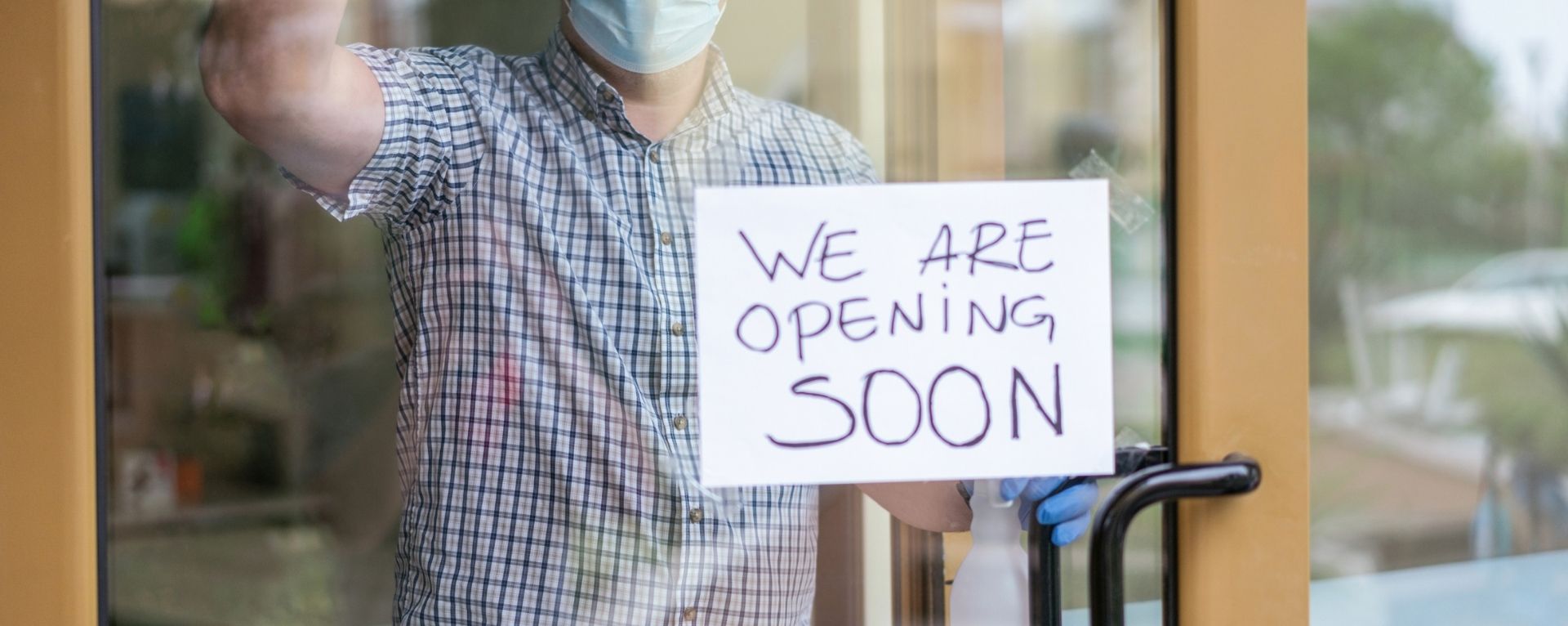
 | Note from Editor: We were so impressed with how thoughtfully this article by Open Mind's CEO Monica Oss summarizes the challenges facing treatment center owners during this turbulent time that we decided to share it with Vista's readers. |
We couldn’t wait for lockdowns to end. But now, the challenge of reopening seems almost insurmountable (see Reopening Is Not Recovery). Most executive teams know where they want to get to but the challenge is getting from lockdown to full opening. In between, there are many additional expenses and, quite likely, several months of financial losses.
In every sector, the costs and risks are looming while the path to business recovery remains fuzzy. Restaurants can’t seat to full capacity and are incurring untold expenses to follow safety guidelines (see The Costs Of Safely Reopening A High-End Restaurant). Airlines have reinstated flights but at 40% or less of former capacity (see U.S. Airlines Add Flights As Demand Increases, But Recovery Will Take Years). Colleges are being forced to offer rebates while more than $70 billion is estimated to be added to the budgets of the nation’s 5,000 colleges (see Covid Tests And Quarantines: Colleges Brace For An Uncertain Fall). Some hair salons and dentist offices are adding a 3% to 5% COVID-19 surcharge to cover the costs of masks, gloves, disinfectants, and plexiglass (see As Businesses Reopen, Some Add A COVID-19 Surcharge). In many states, including Pennsylvania where I live, meetings are limited to a maximum of ten people. And I’ve heard that wedding venues holding outdoor events are asking couples to cut their guest lists in half!
For the health care field, data from the Commonwealth Fund found that health care consumer services started to rebound since their plunge in early April but have flattened out (see The Impact Of The COVID-19 Pandemic On Outpatient Visits: Practices Are Adapting To The New Normal). How long this will last is the question. It depends on both legal mandates (which are often specific to just a single city or county) and consumer confidence. We continue to see an uptick in COVID-19 cases and shutdowns. Labor Day activities may lead to increased crowds and consequently, another spike in cases. The reopening of schools presents additional risks of unknown proportions (see The Importance Of Reopening America’s Schools This Fall). And come September, we also have to prepare to deal with the double whammy of flu season and COVID-19 (see COVID-19 Is Not Just Seasonal, Cautions WHO, As ‘First Wave’ Continues).
The mounting costs and uncertainties of reopening are keeping most specialty health and social service provider organization executives up at night. My colleagues and I are hearing the same questions over and over again from the field. How do we manage cash flow? Who will pay for increased expenses and infrastructure investments for safety—including new COVID units in residential facilities? How many of our consumers will come back and when? Will our furloughed staff come back? How do we increase access while we are strapped for cash? How long can we sustain the losses from opening and running at lower capacity and lower utilization?
We don’t know all the answers. But simply waiting to see how things shake out, or “hoping it will be fine,” which is all some non-profits are doing—can be fatal. Navigating reopening and the increased turbulence that lies ahead requires a moving forward strategy, which addresses two key buckets—the mechanics and the financials.
The Mechanics
The operational planning for reopening is no small task. A big concern is about safety and about liability risks. There are the COVID-19 safety guidelines to follow. Testing, social distancing, use of personal protective equipment, frequent cleaning, and disinfection of work areas are all procedures that add to costs and require new standard operating procedures even though you can’t function at full capacity. There is the need to plan for social distancing—scheduling consumers to avoid having too many people in waiting areas, spacing out staff in physical spaces, and more.
There are a few challenges here. First, I think the guidelines from the Centers for Disease Control and Prevention (CDC) miss the point on safety, with little focus on testing and quarantine. Second, compliance with CDC guidelines is expensive. And finally, any perceived lack of compliance with the guidelines—whether intentional or not—could result in legal liability. We’re just starting to see the first of consumer and/or employee lawsuits (see Families File First Wave of Covid-19 Lawsuits Against Companies Over Worker Deaths).
I’m hearing a common theme among managers of organizations with outpatient services—they’re not reopening. One chief executive officer told me he is thinking of not reopening their outpatient mental health clinic because of the costs of adding increased ventilation capacity in their existing office space. Others are thinking about margins. Is it really worth reopening outpatient clinics when services can be delivered remotely? Staff productivity is higher and costs of rent are eliminated. But the future of telehealth rates and regulations is still unclear.

And if virtual work is the future, what should you do with office space? Luanne Welch, chief executive officer and president of Easterseals UCP, which offers disability-related and behavioral health services, said they are reconfiguring administrative offices in North Carolina and Virginia because the purpose of office space has moved from daily work and meetings (private offices and conference rooms) to spaces where people connect and collaborate. “We no longer want to pay for real estate to have people come in just to be there. They will come in when they need to be together in person.” Collaborative space is typically less expensive to create on a per employee basis, she explained. They are scaling back on square footage and focusing on the right amount of conference, training and ‘all-hands’ gathering space for face-to-face interaction. “Those who can work from home have typically been more productive doing so, less travel time and less burden on the associated infrastructure. In addition to finding ways to better support working from home, we want to create the best space possible for needed (and missed) in-person connection and collaboration,” she added.
The Financials
The other big issue in reopening is the financial losses that will be incurred for some period of time. Operating a facility at partial capacity with full costs is a formula for red ink. Any reopening plans need detailed financial projections and cash flow estimates for multiple scenarios—pre-pandemic consumer volume, drastically lower volume, somewhat lower volume, etc. The big question is what does the curve to profitability look like? How big will the losses be in the reopening period and how long will it be to breakeven? What is the plan to sustain operations until then?
Even for programs that have been open during the pandemic crisis, the capacity issue is problematic. In a recent discussion with a manager of a residential addiction treatment program, I learned that their maximum capacity—in order to comply with social distancing rules—is now 70%.
Easterseals is using service line portfolio management to plan their recovery strategy. “We evaluate our program portfolio risk and return on both mission sustainability and financial grids. We understand our current state, have drafted a more resilient (more ‘COVID resistant’) future state portfolio, and we are making the necessary changes to move forward,” said Ms. Welch.

Our team also talked to Brad Howell, president and chief executive officer of Fidelity House, a Massachusetts provider organization serving people with intellectual and developmental disabilities. They reopened their community-based day supports program this week (on August 3) and plan to open more in-person services in a second wave on August 24. While the first wave of reopening has worked well and the organization wants to sustain the program which is core to the mission, there are many challenges says Mr. Howell.
Fidelity House had to lay off 80% of its day program staff at the start of its new fiscal year on July 1, when Paycheck Protection Program funding ran out. Right now, family members are driving consumers to the day program but when more consumers who rely on public transport are able to come in, social distancing schedules will make commuting much harder. And residents in congregate care facilities don’t want their housemates having too much contact with the outside world.
Another issue is rates. The state (Massachusetts) raised reimbursement rates by 40% during COVID-19 but that is soon scaling back to 25%, and eventually back to pre-pandemic rates. Without the enhanced rates and with the lower service volume, financial sustainability is challenging. “We just can’t cut any more expenses,” said Mr. Howell. He also points out that they need more fluidity and flexibility in how to achieve better outcomes, which their currently rigid contracts don’t allow. “We need to meet with our payers and set a new vision together,” he added.
As part of their move forward strategy, said Mr. Howell, they are engaging in strategic planning right now to “realign their building blocks and mitigate risk.” They are looking at what would happen if certain programs have to be closed. They’re reevaluating office space (as many staff can continue to work virtually) to downsize and cut down on overheads. And they are thinking about how to expand services beyond consumers with disabilities. For example, the increased focus on social determinants of health provides opportunities to extend remote programs to other isolated populations such as the elderly—Fidelity House recently partnered with the local elder services agency to submit a grant proposal. “With virtual services, we are not bound to our current consumers, or our current geographic boundaries,” Mr. Howell pointed out.
Thinking differently—in terms of populations, services, and service delivery—is a must for managing through the pandemic crisis. A strategy, a detailed operating plan, and good cash flow projections are needed to make thinking differently a successful reality. For more on strategies for survival and recovery, check out these resources in The OPEN MINDS Industry Library:
Managing Your Service Portfolio Is Key To Crisis Recovery
Nursing Home Problems Are Problems For The Entire System
Strategic Planning For Post-Disruption Recovery & Sustainability
Opportunistic Business Development – Responding To New Market Needs, Quickly
Using Mergers, Acquisitions & Affiliations To Address ‘Urgent’ Cashflow Needs
Blended Virtual & Onsite Services For Continuity Of Care
Revenue Maximization During Times Of Disruption – Building Top Line To Sustain Margins – An Overview
Short-Term Cash Management – To Assuring Continued Operations – An Overview
Creating A Sustainable Growth Strategy In A Rapidly Changing Market
And, if you’re an Elite member of the OPEN MINDS Circle, I invite you to take advantage of a quick consult with one of our senior advisors on strategic planning. Email us at openminds@openminds.com to schedule the session.
This reprint appears with the permission of OPEN MINDS. For more information, visit their website at www.openminds.com. To contact the author, email openminds@openminds.com.

